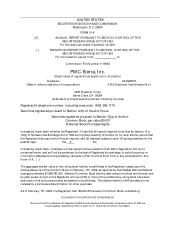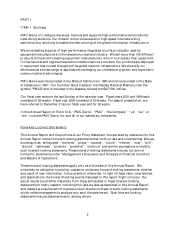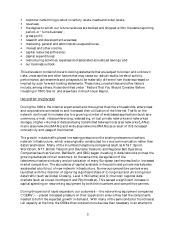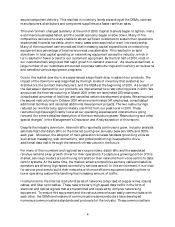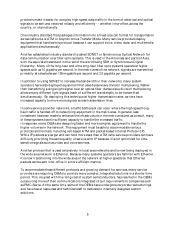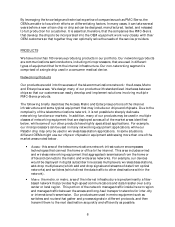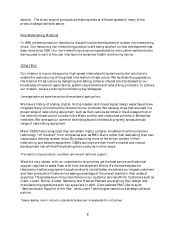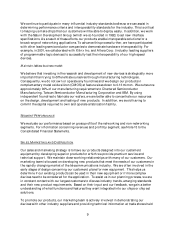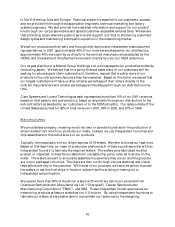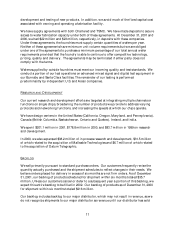Adaptec 2001 Annual Report Download - page 7
Download and view the complete annual report
Please find page 7 of the 2001 Adaptec annual report below. You can navigate through the pages in the report by either clicking on the pages listed below, or by using the keyword search tool below to find specific information within the annual report. 7
• Enterprise: this area of the network includes equipment that is deployed in the home or
office for data communications and other local area netw ork applications. Our products
are used in equipment such as networked printers in the office or home, as well as
switches and storage devices that enable data to be transferred to local
telecommunications netw orks and storage area networks.
Our chips and chipsets can also be divided into the broadly defined functional categories
identified below. As with descriptions of the netw ork, particular categories may overlap and a
device may be present in more than one category. In addition, some products, particularly
multiple chip sets, integrate different functions and could be classified in one or more
categories. For example, some of our products both convert high-speed analog signals to
digital signals, and also split or combine various transmission signals.
• Line interface units: these devices, also referred to as transceivers, transmit and receive
signals over a physical medium such as wire, cable or fiber. The line interface unit
determines the speed and timing characteristics of the signals, and may also convert
them from a serial stream of data into a parallel stream before they are further processed
for transmission to the next destination.
• Framers & mappers: before the data can be sent to the next destination, it must be
converted into a proper format for transmission in the netw ork. For example, the
framing function arranges the bits into different size formats, commonly referred to as
“ cell” or “ packet” formats, and attaches the appropriate information to the formats to
ensure they reach their destinations. In turn, this data may be inserted into other
frames, such as SONET frames, for transmission across high-speed fiber optics.
• Packet & cell processors: these devices examine the contents of cells or packets and
performs various management and reporting functions. For instance, a switch or router
may use a packet or cell processor to determine if a signal is voice or video in order to
allocate the proper amount of bandwidth. Service providers can use information
gathered by the cell or packet processor to determine a customers’ network usage and
charge the appropriate service fee.
• Traffic managers & switch fabrics: traffic managers organize, schedule and queue cells
and packets into and out of switches. Switch fabrics interconnect the wires and fibers,
allowing the data to be routed to its intended destination.
• Serializers/ Deserializers: these devices convert networking traffic from slower speed
parallel streams into higher speed serial streams and visa versa. OEM s use serial streams
to reduce networking equipment line connections. Conversely, OEMs use parallel
streams to allow them to use lower cost traffic management technologies.
• Microprocessors: these devices perform the high-speed computations that help identify
and control the flow of signals and data in the many different types of netw ork
equipment used in the communications, enterprise and consumer markets.
Our products help OEM s both aggregate and disaggregate network traffic at high and low
speeds. As signals move through the netw ork, carriers aggregate millions of slow-speed
incoming signals through access devices into a few high-speed and high-capacity signals. For
example, slower-speed access lines such as T1 lines (operating at 1.54 megabits per second) are
aggregated and streamed into high-speed lines (such as optical transmission at 2.5 gigabits per

